An Experimental Investigation on Micro End Milling with High-Speed Up Cut Milling for Hardened Die Steel
Abstract
1. Introduction
2. Experimental Methods
3. Experimental Results and Discussion
3.1. Improvement of Machined Surface Quality by High-Speed Up Cut Milling
3.2. Influence of Higher Feed Rate Milling
4. Conclusions
- In high-speed up cut milling, with say 157 m/min (100,000 min−1) of cutting speed, the progress of tool wear can be suppressed. This results in an increase of approximately 30% of tool life compared with that in down cut milling.
- High-speed up cut milling improves not only the surface roughness but also the dimensional accuracy.
- The machined surface in high-speed up cut milling is smooth with non-observable cutting marks.
- At a small feed rate, undulation occurs on the machined surface, which is generated by the single-flute cutting surface.
- High-efficiency and long tool life machining can be achieved by high-speed up cut milling and high-feed cutting, unless chipping due to overload occurs.
Author Contributions
Funding
Conflicts of Interest
References
- Chen, W.; Huo, D.; Tenga, X.; Sun, Y. Surface generation modelling for micro end milling considering the minimum chip thickness and tool runout. Procedia Cirp. 2017, 58, 364–369. [Google Scholar] [CrossRef]
- Kumar, S.L. Experimental investigations and empirical modeling for optimization of surface roughness and machining time parameters in micro end milling using Genetic Algorithm. Measurements 2018, 124, 386–394. [Google Scholar] [CrossRef]
- Moges, T.M.; Desai, K.A.; Rao, P.V.M. Improved process geometry model with cutter runout and elastic recovery in micro-end milling. Procedia Manuf. 2016, 5, 478–494. [Google Scholar] [CrossRef]
- Goto, D.; Maeda, Y.; Tanaka, H.; Kato, K.; Yazawa, T. Influence of Tool Run-Out on Machining Accuracy with Multi-Tooth Endmill. Int. J. Autom. Technol. 2016, 10, 759–766. [Google Scholar] [CrossRef]
- Zaman, M.; Kumar, A.S.; Rahman, M.; Sreeram, S. A three-dimensional analytical cutting force model for micro end milling operation. Int. J. Mach. Tools Manuf. 2006, 46, 353–366. [Google Scholar] [CrossRef]
- Srinivasa, Y.; Shunmugam, M. Mechanistic model for prediction of cutting forces in micro end-milling and experimental comparison. Int. J. Mach. Tools Manuf. 2013, 67, 18–27. [Google Scholar] [CrossRef]
- Zhou, L.; Peng, F.Y.; Yan, R.; Yao, P.F.; Yang, C.; Li, B. Analytical modeling and experimental validation of micro end-milling cutting forces considering edge radius and material strengthening effects. Int. J. Mach. Tools Manuf. 2015, 97, 29–41. [Google Scholar] [CrossRef]
- Kang, I.; Kim, J.; Kang, M.; Seo, Y. A mechanistic model of cutting force in the micro end milling process. J. Mater. Process. Technol. 2007, 187–188, 250–255. [Google Scholar] [CrossRef]
- Wojciechowski, S.; Matuszak, M.; Powałka, B.; Madajewski, M.; Maruda, R.; Królczyk, G. Prediction of cutting forces during micro end milling considering chip thickness accumulation. Int. J. Mach. Tools Manuf. 2019, 147, 103466. [Google Scholar] [CrossRef]
- Yuan, Y.; Jing, X.; Ehmann, K.F.; Cao, J.; Li, H.; Zhang, D. Modeling of cutting forces in micro end-milling. J. Manuf. Process. 2018, 31, 844–858. [Google Scholar] [CrossRef]
- Jing, X.; Lv, R.; Chen, Y.; Tian, Y.; Li, H. Modelling and experimental analysis of the effects of run out, minimum chip thickness and elastic recovery on the cutting force in micro-end-milling. Int. J. Mech. Sci. 2020, 176, 105540. [Google Scholar] [CrossRef]
- Zhang, X.; Yu, T.B.; Wang, W. Prediction of cutting forces and instantaneous tool deflection in micro end milling by considering tool run-out. Int. J. Mech. Sci. 2018, 136, 124–133. [Google Scholar] [CrossRef]
- Sahoo, P.; Pratap, T.; Patra, K. A hybrid modelling approach towards prediction of cutting forces in micro end milling of Ti-6Al-4V titanium alloy. Int. J. Mech. Sci. 2019, 150, 495–509. [Google Scholar] [CrossRef]
- Zhang, X.; Ehmann, K.F.; Yu, T.B.; Wang, W. Cutting forces in micro-end-milling processes. Int. J. Mach. Tools Manuf. 2016, 107, 21–40. [Google Scholar] [CrossRef]
- Bohley, M.; Kieren-Ehses, S.; Heberger, L.; Kirsch, B.; Aurich, J.C. Size limitations and wear behavior of TiB2 coated micro end mills (Ø < 50 µm) when machining cp-titanium. Procedia Cirp. 2018, 71, 187–191. [Google Scholar]
- Bandapalli, C.; Sutaria, B.M.; Bhatt, D.V.P.; Singh, K.K. Tool Wear Analysis of Micro End Mills—Uncoated and PVD Coated TiAlN & AlTiN in High Speed Micro Milling of Titanium Alloy—Ti-0.3Mo-0.8Ni. Procedia Cirp. 2018, 77, 626–629. [Google Scholar] [CrossRef]
- Reichenbach, I.G.; Bohley, M.; Sousa, F.J.P.; Aurich, J.C. Tool-life criteria and wear behavior of single-edge ultra-small micro end mills. Precis. Eng. 2019, 55, 48–58. [Google Scholar] [CrossRef]
- Vipindas, K.; Mathew, J. Wear behavior of TiAlN coated WC tool during micro end milling of Ti-6Al-4V and analysis of surface roughness. Wear 2019, 424–425, 165–182. [Google Scholar] [CrossRef]
- Alhadeff, L.; Marshall, M.; Slatter, T. The influence of tool coating on the length of the normal operating region (steady-state wear) for micro end mills. Precis. Eng. 2019, 60, 306–319. [Google Scholar] [CrossRef]
- Swain, N.; Venkatesh, V.; Kumar, P.; Srinivas, G.; Ravishankar, S.; Barshilia, H.C. An experimental investigation on the machining characteristics of Nimonic 75 using uncoated and TiAlN coated tungsten carbide micro-end mills CIRP. J. Manuf. Sci. Technol. 2017, 16, 34–42. [Google Scholar] [CrossRef]
- Kino, H.; Oda, Y.; Imada, T.; Nakagawa, H.; Ogawa, K.; Kojima, H. Basic study on micro end-milling–cutting phenomena of side cutting. J. SME Jpn. 2014, 3, 6–10. [Google Scholar]
- D’Errico, G.; Guglielmi, E.; Rutelli, G. A study of coatings for end mills in high speed metal cutting. J. Mater. Process. Technol. 1999, 92, 251–256. [Google Scholar] [CrossRef]
- Miyaguchi, T.; Masuda, M.; Takeoka, E.; Iwabe, H. Effect of tool stiffness upon tool wear in high spindle speed milling using small ball end mill. Precis. Eng. 2001, 25, 145–154. [Google Scholar] [CrossRef]
- Kita, Y.; Furuike, H.; Kakino, Y.; Nakagawa, H.; Hirogaki, T. Basic study of ball end milling on hardened steel. J. Mater. Process. Technol. 2001, 111, 240–243. [Google Scholar] [CrossRef]
- Koshy, P.; Dewes, R.; Aspinwall, D. High speed end milling of hardened AISI D2 tool steel (∼58 HRC). J. Mater. Process. Technol. 2002, 127, 266–273. [Google Scholar] [CrossRef]
- Soković, M.; Kopač, J.; Dobrzański, L.A.; Adamiak, M. Wear of PVD-coated solid carbide end mills in dry high-speed cutting. J. Mater. Process. Technol. 2004, 157–158, 422–426. [Google Scholar] [CrossRef]
- Axinte, D.; Dewes, R. Surface integrity of hot work tool steel after high speed milling-experimental data and empirical models. J. Mater. Process. Technol. 2002, 127, 325–335. [Google Scholar] [CrossRef]
- Kang, M.C.; Park, I.-W.; Kim, K.H. Performance evaluation of AIP-TiAlN coated tool for high speed machining. Surf. Coat. Technol. 2003, 163–164, 734–738. [Google Scholar] [CrossRef]
- Ning, L.; Veldhuis, S.C. Mechanistic Modeling of Ball End Milling Including Tool Wear. J. Manuf. Process. 2006, 8, 21–28. [Google Scholar] [CrossRef]
- Buj-Corral, I.; Vivancos-Calvet, J.; Gonzalez-Rojas, H. Influence of feed, eccentricity and helix angle on topography obtained in side milling processes. Int. J. Mach. Tools Manuf. 2011, 51, 889–897. [Google Scholar] [CrossRef]


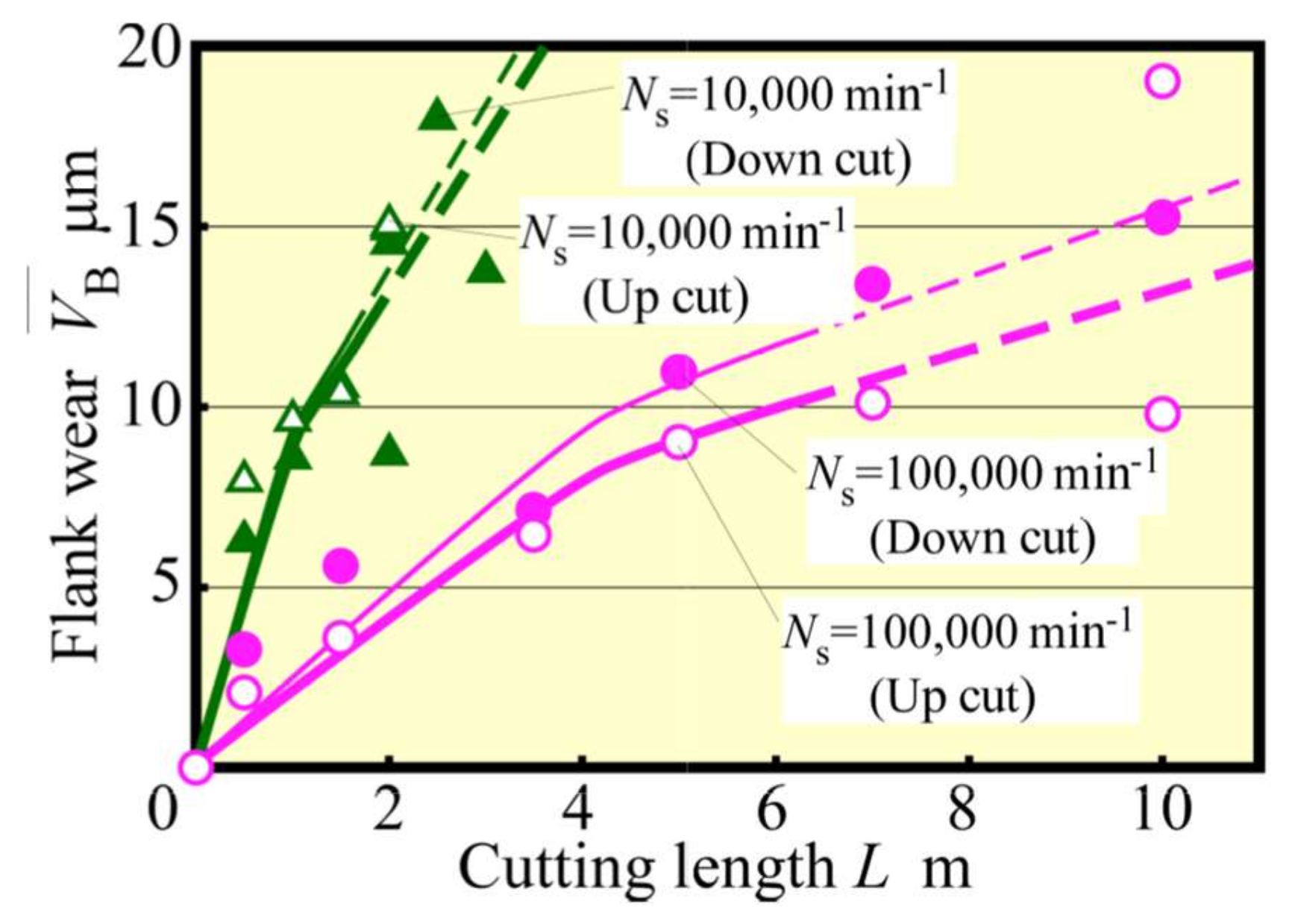
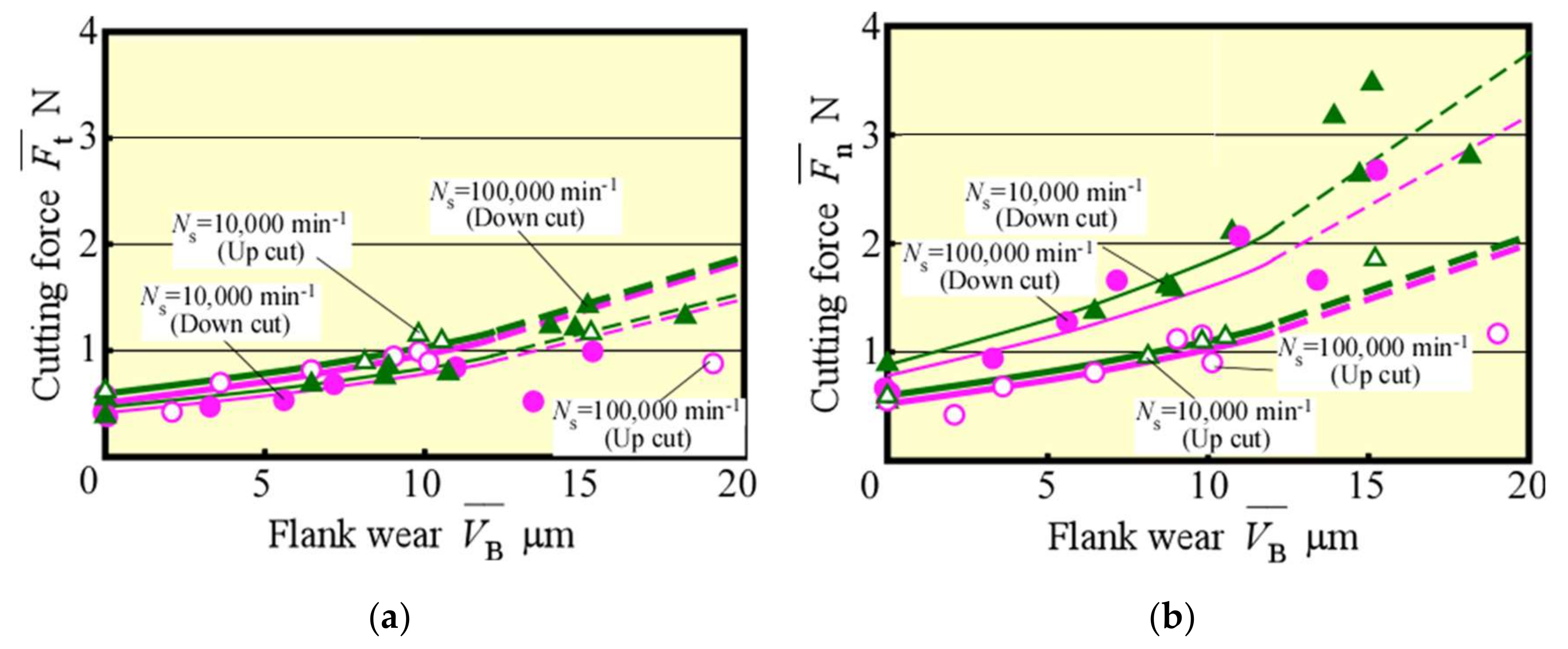
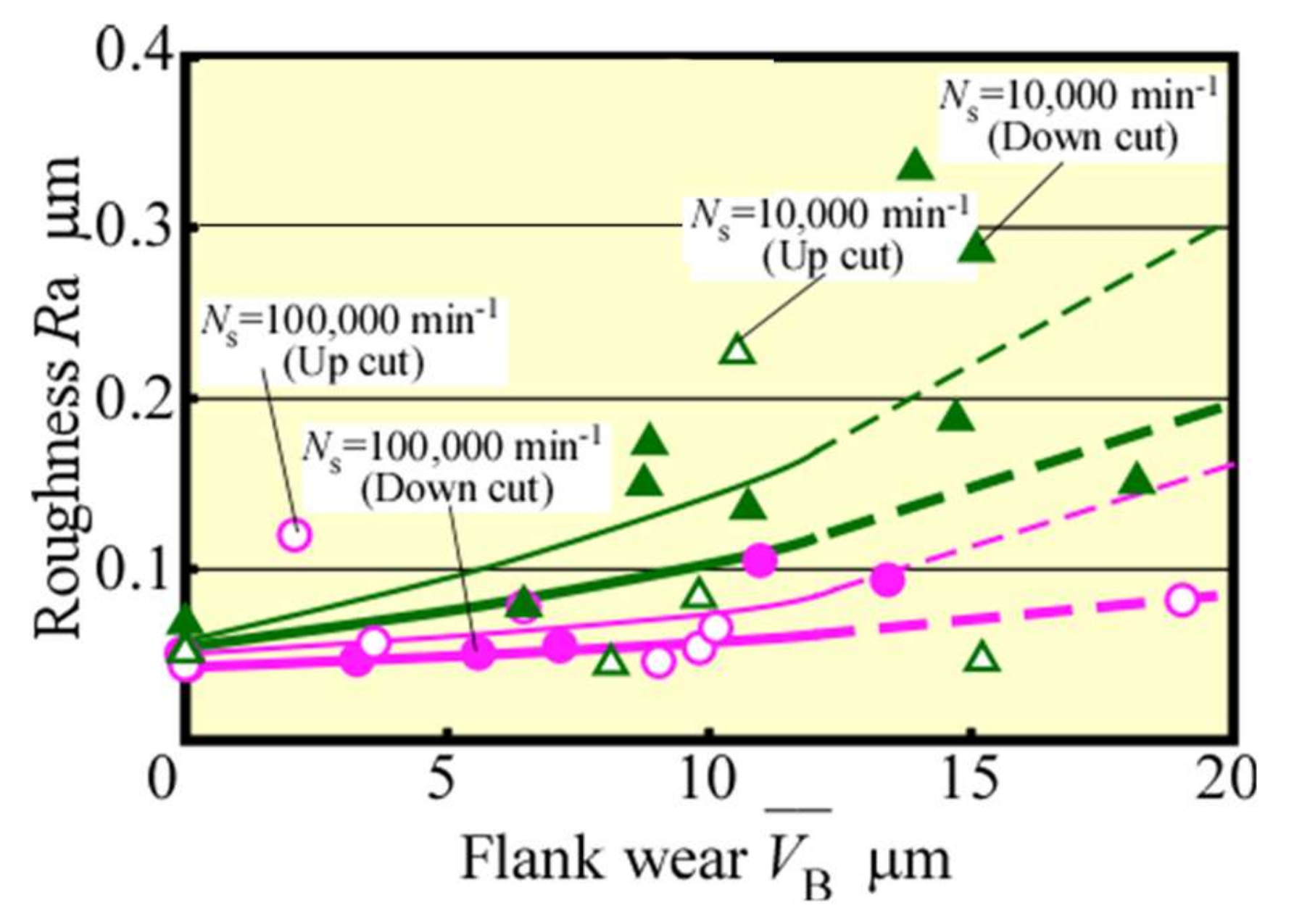

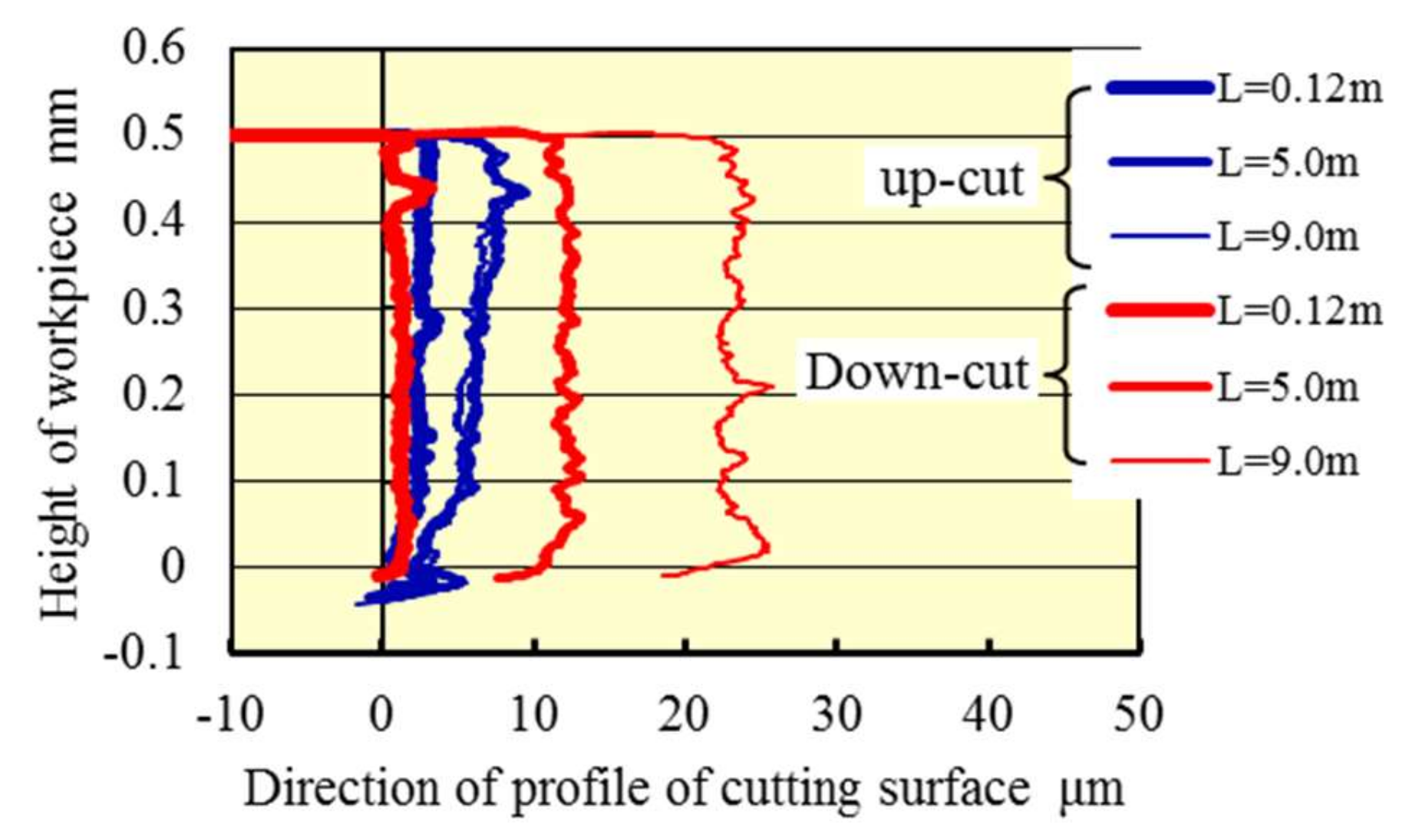
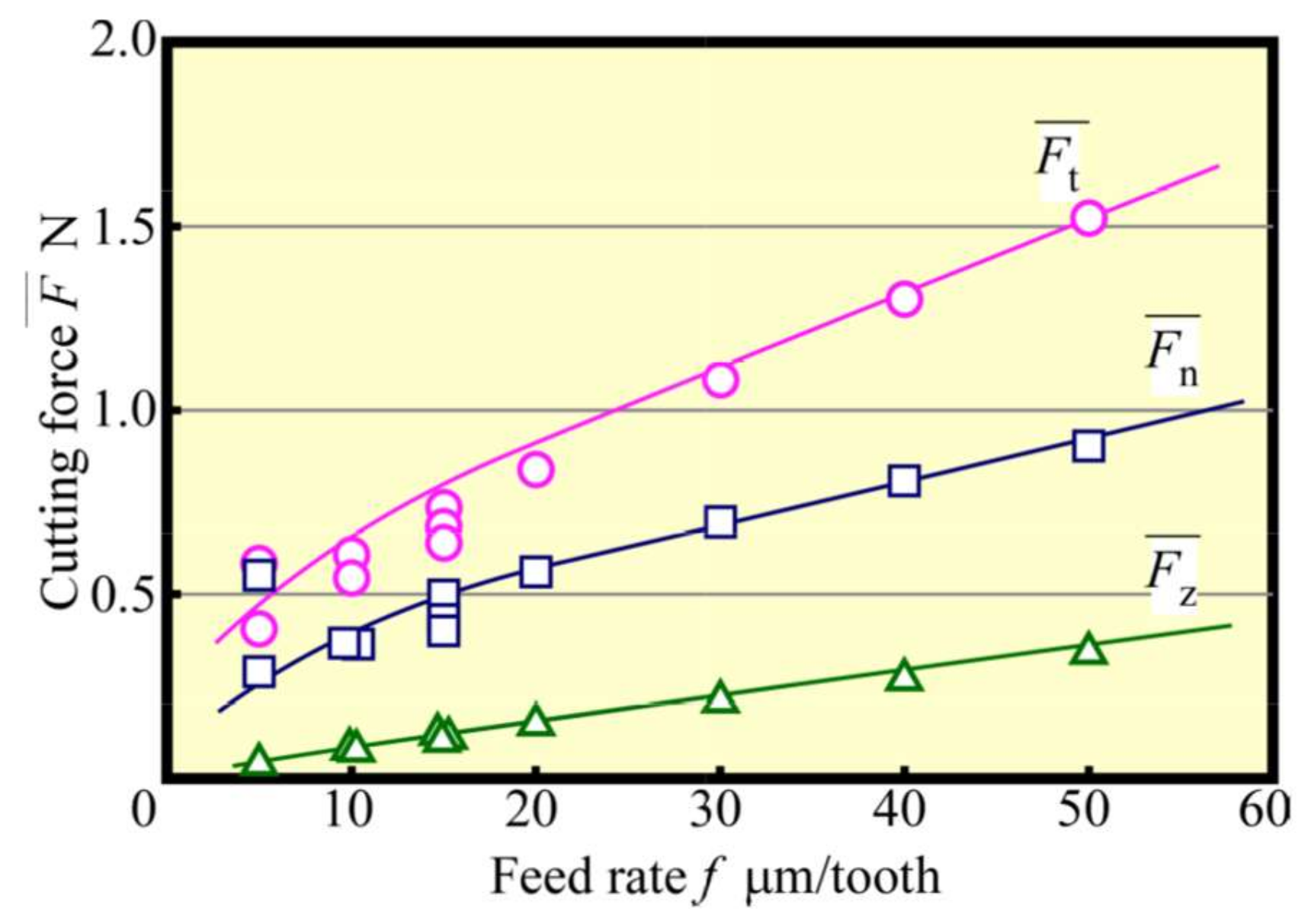
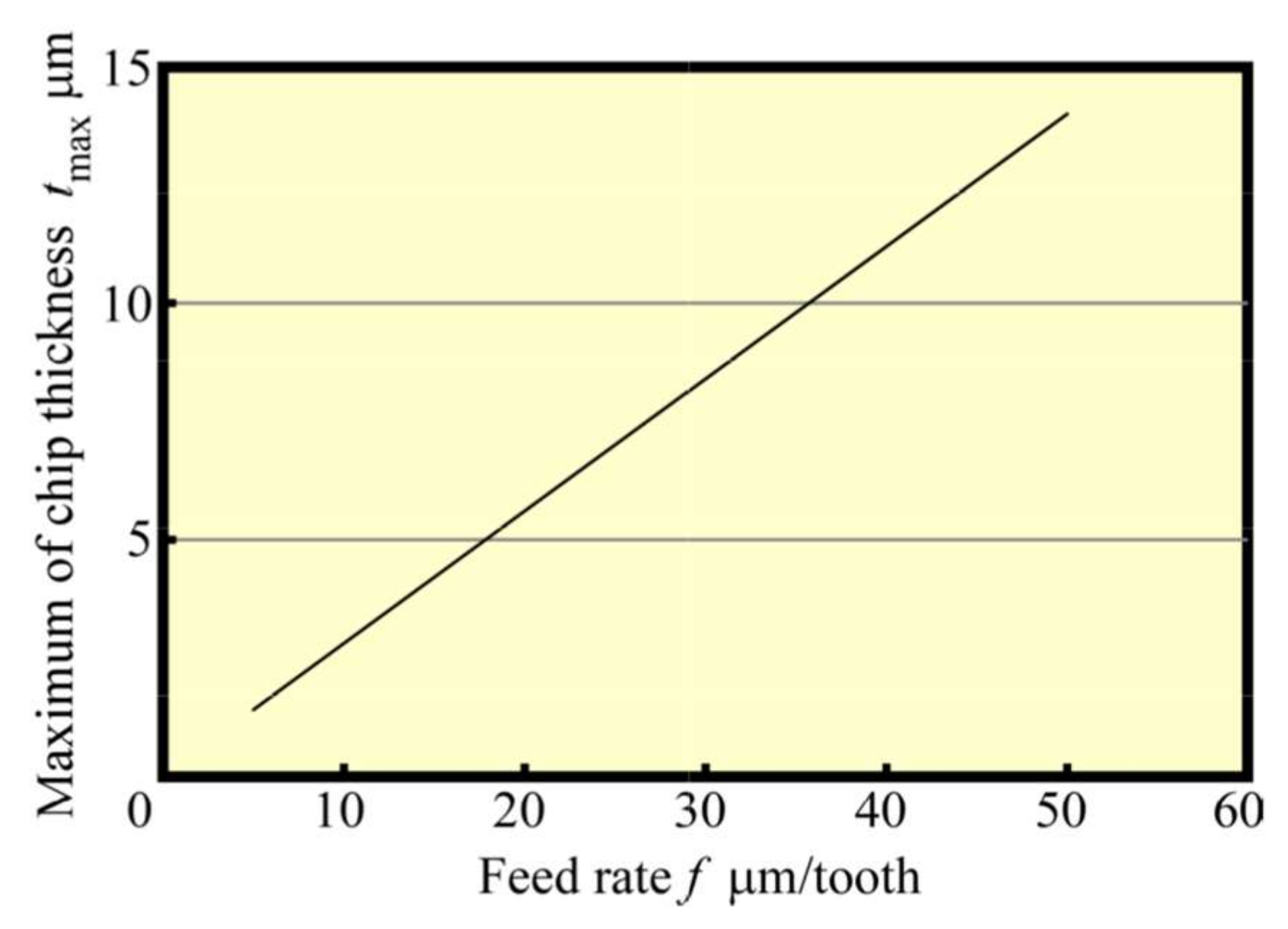
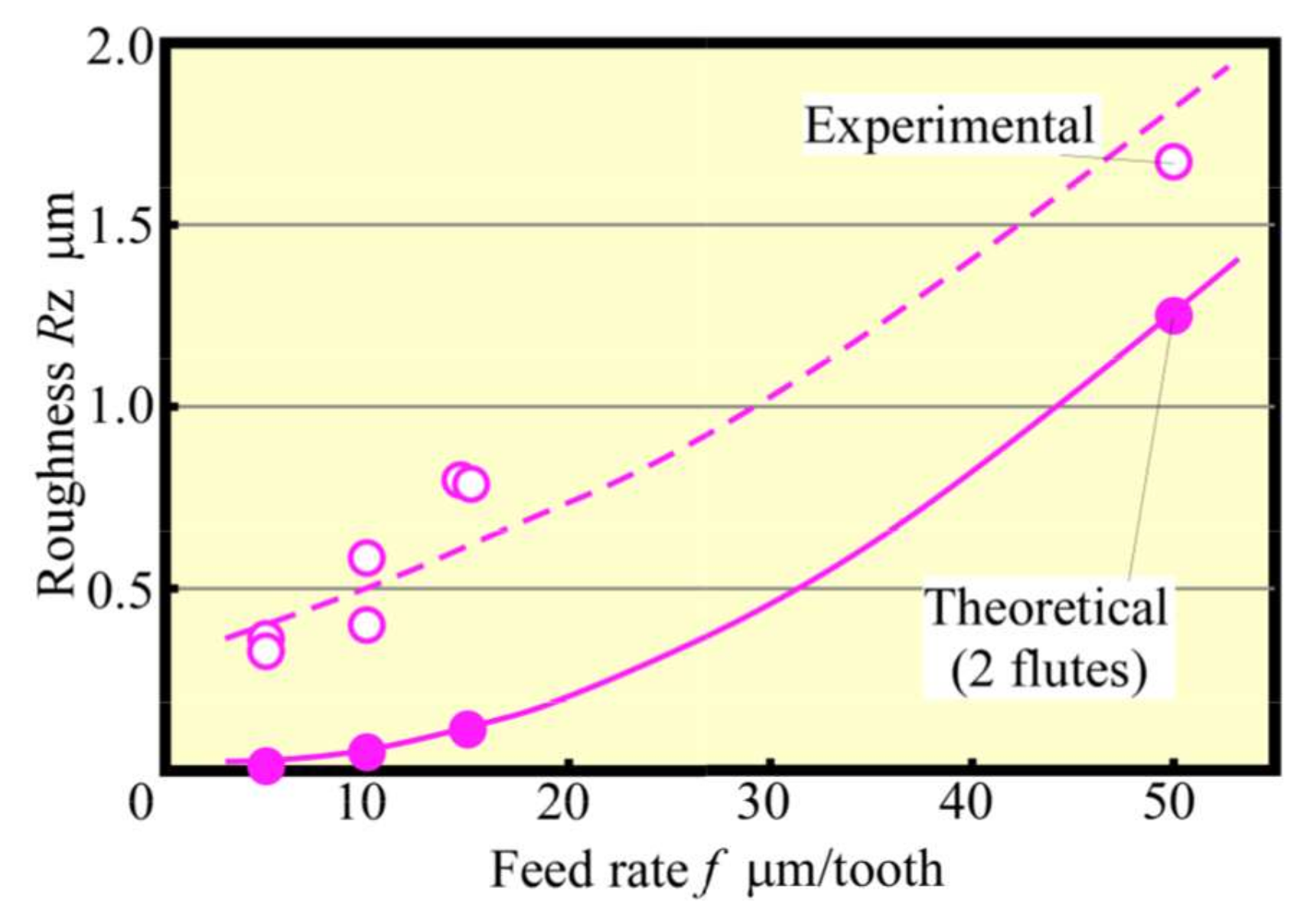
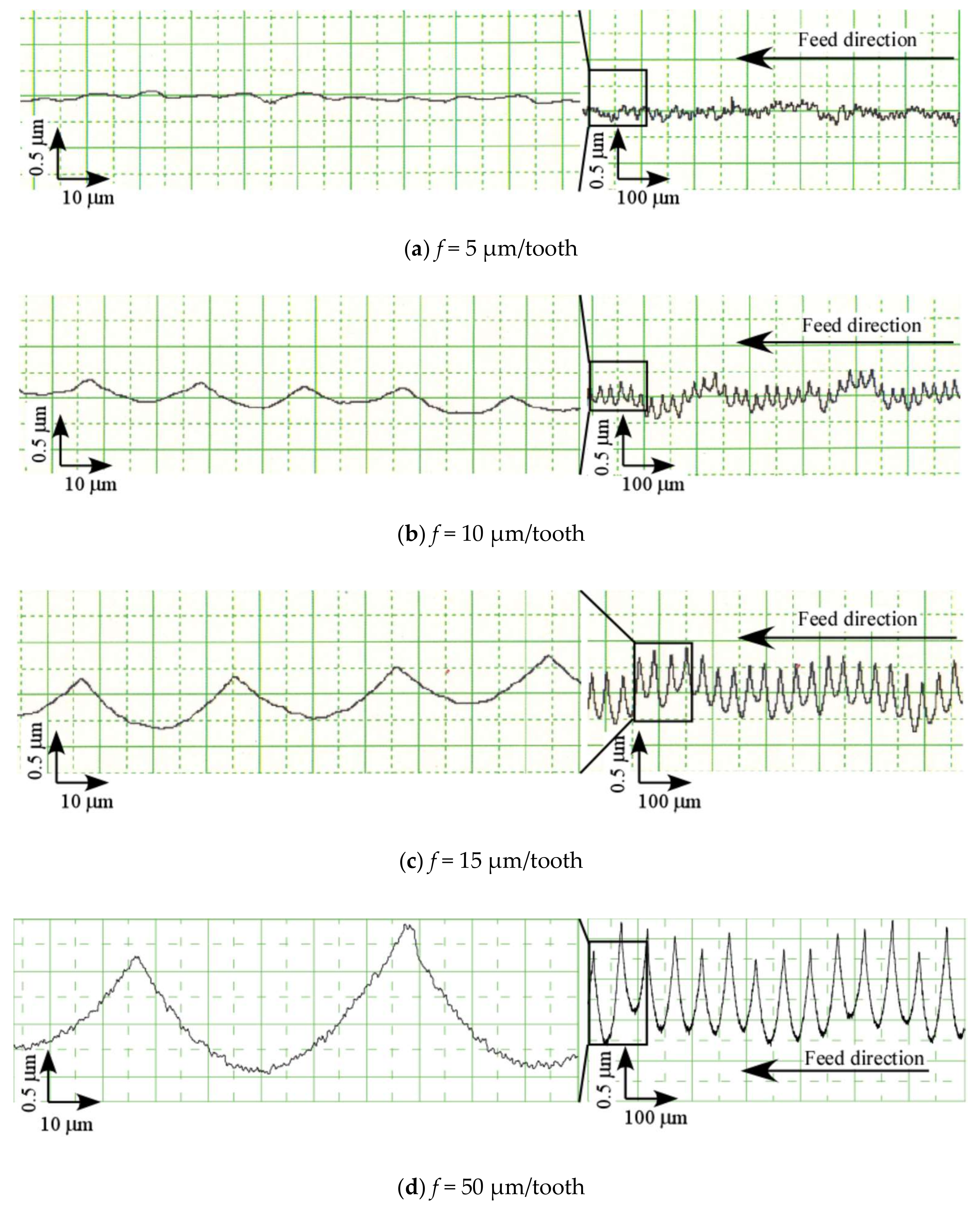
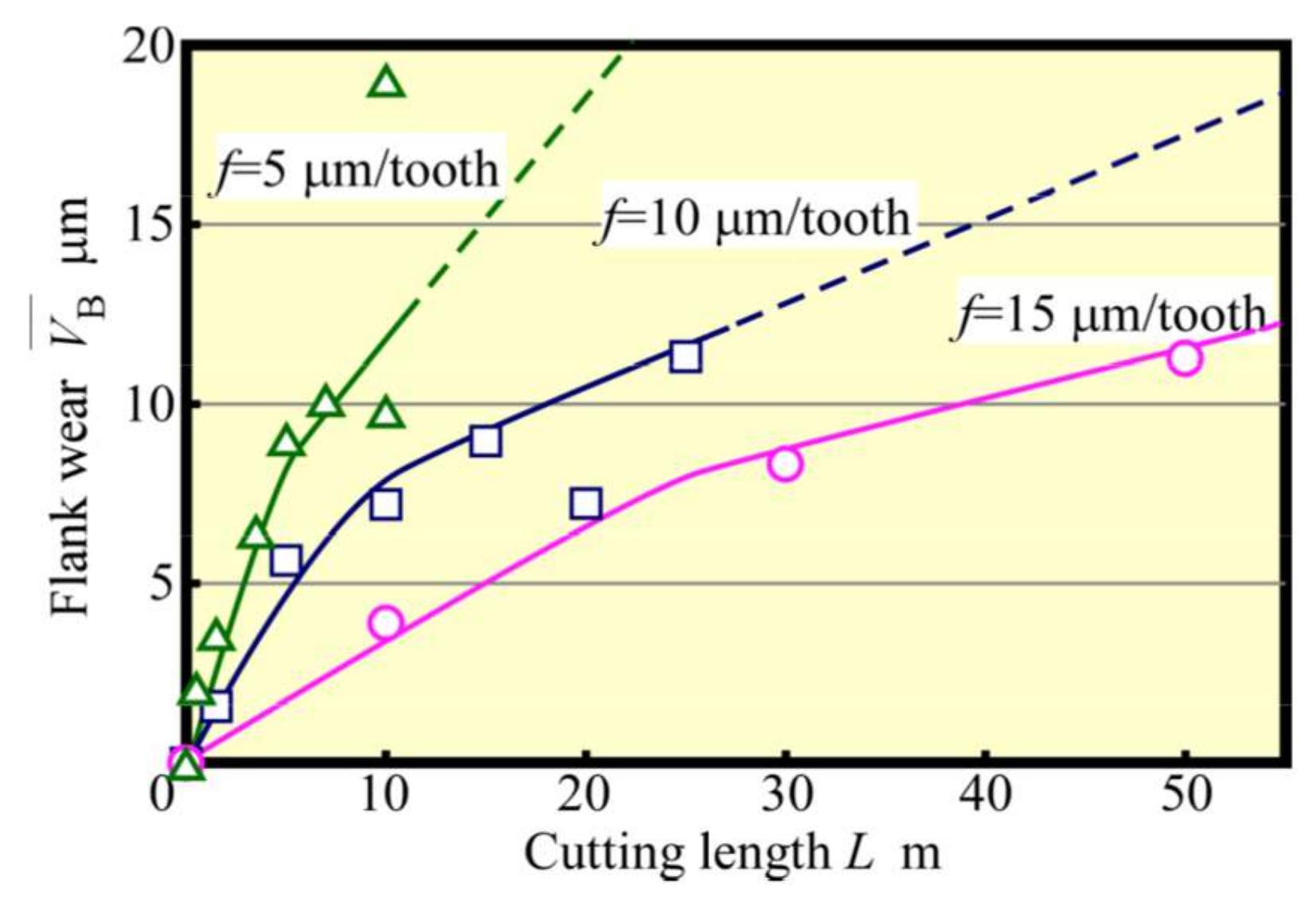
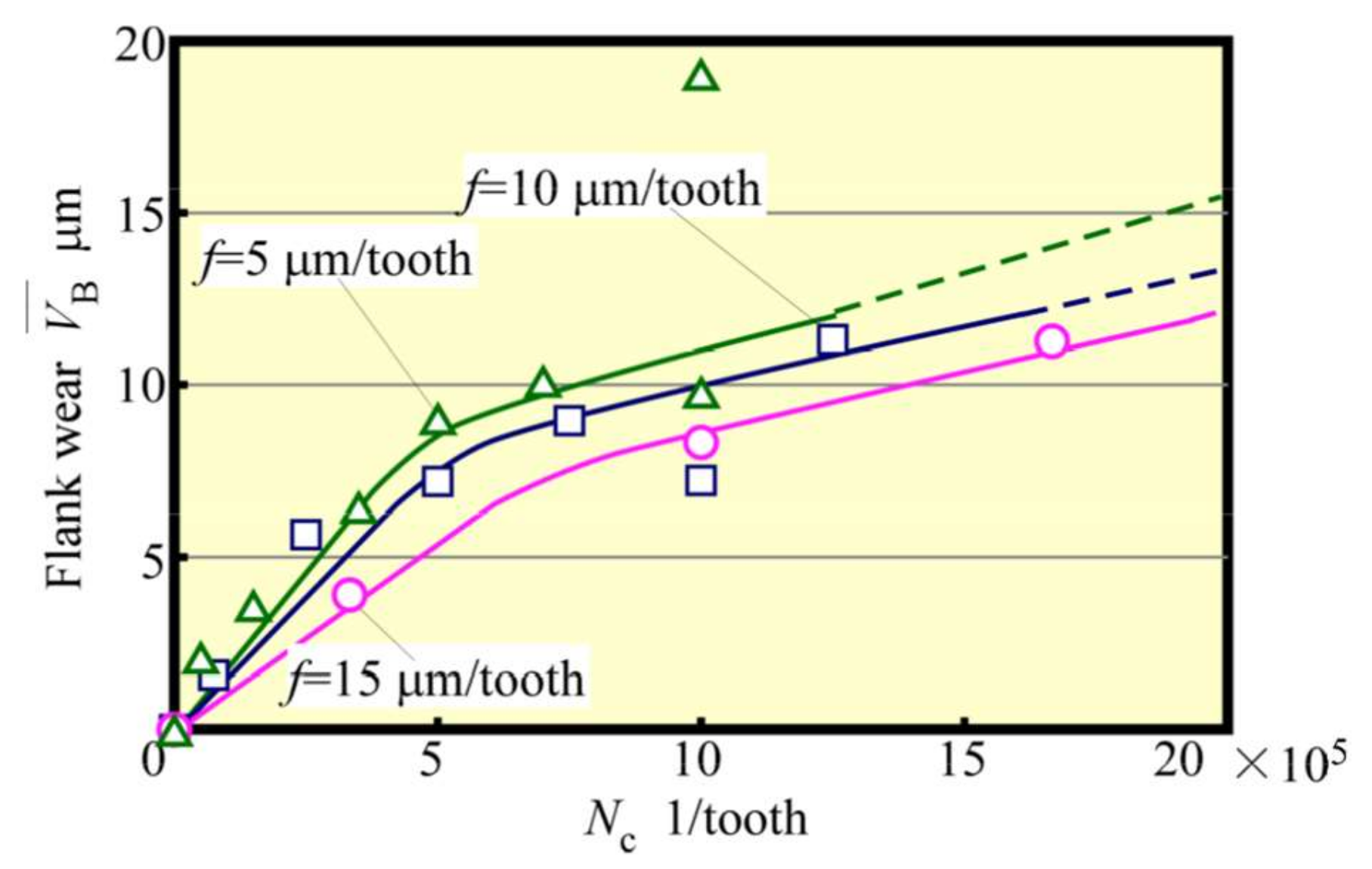
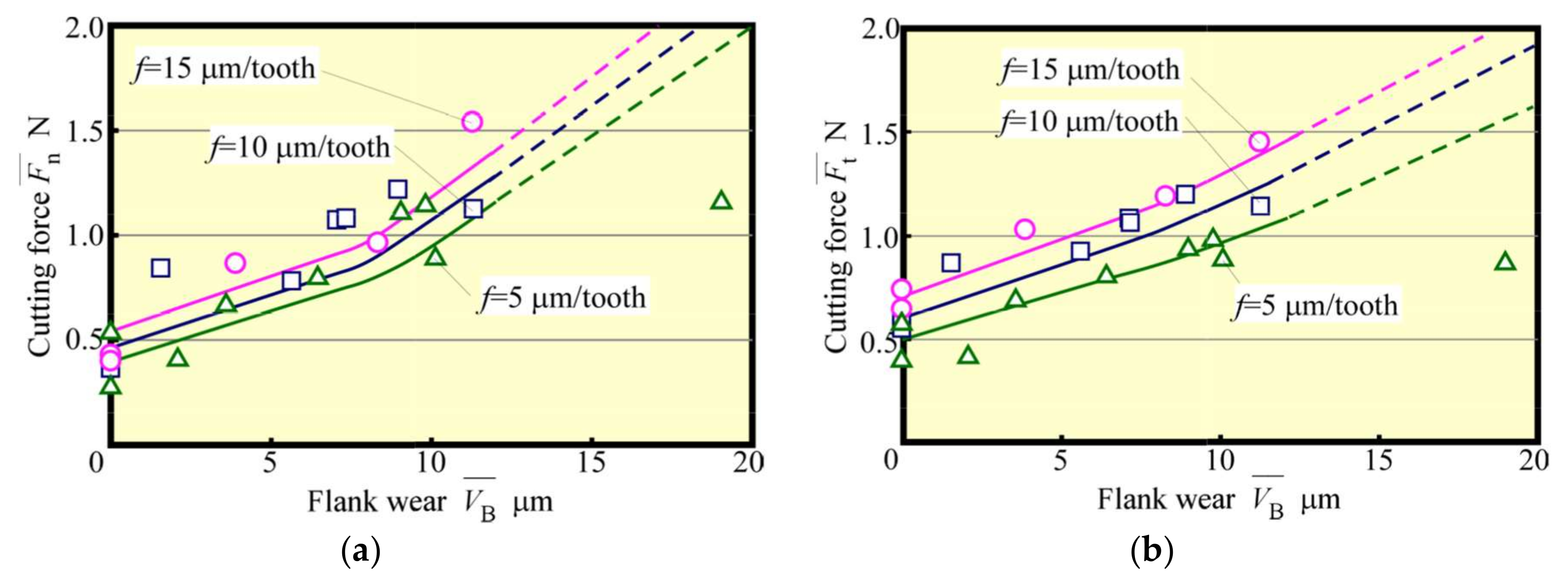
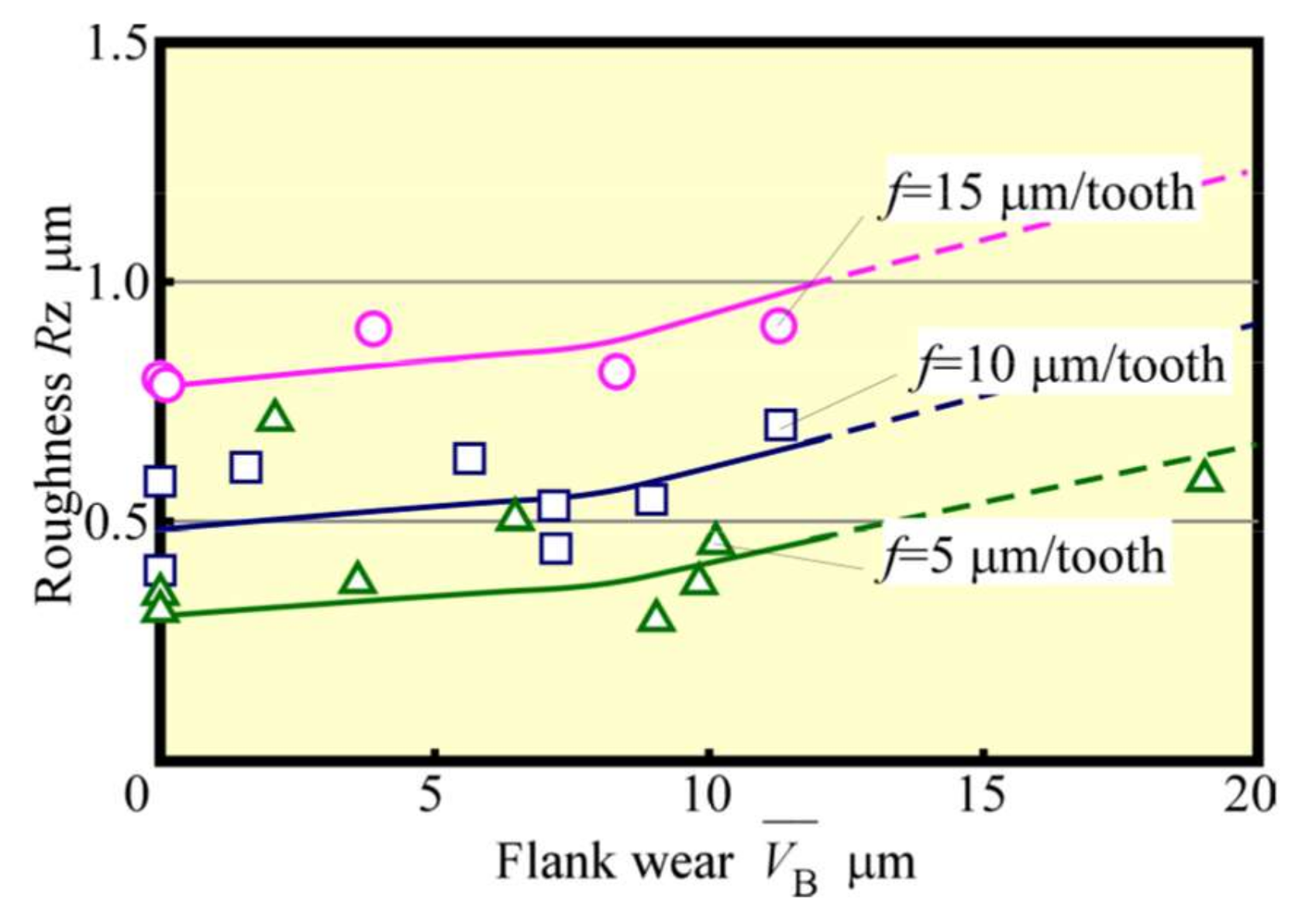
| Workpiece | JIS: SKD61 53HRC |
| Spindle Speed Ns, min−1 (Cutting Speed Vc, m/min) | 10,000, 100,000 (15.7), (157) |
| Feed Rate f, μm/tooth | 5–50 |
| Radial Depth of cut Rd, μm | 10 |
| Axial Depth of cut Ad, mm | 0.5 |
| Cutting Length, L m | 0–10 |
| Cutting Direction | Up Cut, Down Cut |
| Tool Run Out, μm | <1 |
| Coolant | Dry Air |
| Feed Rate f µm/Tooth | Theoretical Roughness (2 Flutes) µm | Theoretical Roughness (1 Flute) µm |
|---|---|---|
| 5 | 0.013 | 0.050 |
| 10 | 0.050 | 0.200 |
| 15 | 0.113 | 0.450 |
| 20 | 0.200 | 0.800 |
| 30 | 0.450 | 1.800 |
| 50 | 1.250 | 5.000 |
Publisher’s Note: MDPI stays neutral with regard to jurisdictional claims in published maps and institutional affiliations. |
© 2020 by the authors. Licensee MDPI, Basel, Switzerland. This article is an open access article distributed under the terms and conditions of the Creative Commons Attribution (CC BY) license (http://creativecommons.org/licenses/by/4.0/).
Share and Cite
Kino, H.; Imada, T.; Ogawa, K.; Nakagawa, H.; Kojima, H. An Experimental Investigation on Micro End Milling with High-Speed Up Cut Milling for Hardened Die Steel. Materials 2020, 13, 4745. https://doi.org/10.3390/ma13214745
Kino H, Imada T, Ogawa K, Nakagawa H, Kojima H. An Experimental Investigation on Micro End Milling with High-Speed Up Cut Milling for Hardened Die Steel. Materials. 2020; 13(21):4745. https://doi.org/10.3390/ma13214745
Chicago/Turabian StyleKino, Haruki, Takumi Imada, Keiji Ogawa, Heisaburo Nakagawa, and Hitomi Kojima. 2020. "An Experimental Investigation on Micro End Milling with High-Speed Up Cut Milling for Hardened Die Steel" Materials 13, no. 21: 4745. https://doi.org/10.3390/ma13214745
APA StyleKino, H., Imada, T., Ogawa, K., Nakagawa, H., & Kojima, H. (2020). An Experimental Investigation on Micro End Milling with High-Speed Up Cut Milling for Hardened Die Steel. Materials, 13(21), 4745. https://doi.org/10.3390/ma13214745




